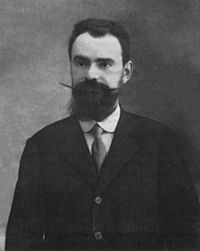Federigo Enriques facts for kids
Quick facts for kids
Federigo Enriques
|
|
|---|---|
 |
|
| Born | 5 January 1871 |
| Died | 14 June 1946 (aged 75) |
| Nationality | Italian |
| Alma mater | Scuola Normale Superiore di Pisa |
| Known for | Enriques surface Enriques–Babbage theorem Enriques–Kodaira classification |
| Scientific career | |
| Fields | Mathematics |
| Institutions | University of Bologna Sapienza University of Rome |
| Doctoral advisor | Enrico Betti Guido Castelnuovo |
Federigo Enriques was an important Italian mathematician. He was born on January 5, 1871, and passed away on June 14, 1946. He is best known for being the first person to group and organize different types of algebraic surfaces. This work was in a field of math called birational geometry. He also made many other important contributions to algebraic geometry.
Contents
About Federigo Enriques
Federigo Enriques was born in Livorno, Italy. He grew up in Pisa. His family was Jewish and originally from Portugal. His younger brother, Paolo Enriques, became a zoologist.
Federigo studied under Guido Castelnuovo. Castelnuovo later married Federigo's sister, Elbina. Federigo became a key member of the "Italian school of algebraic geometry." This was a group of mathematicians in Italy who worked on similar ideas. He also studied differential geometry, which looks at shapes and spaces using calculus. He often worked with other famous mathematicians like Castelnuovo, Corrado Segre, and Francesco Severi.
Enriques taught at the University of Bologna and later at the Sapienza University of Rome. In 1938, he lost his job because of unfair laws passed by the government at the time. These laws prevented Jewish people from being university professors.
Understanding Algebraic Surfaces
Federigo Enriques is famous for his work on classifying complex algebraic surfaces. An algebraic surface is like a 3D shape that can be described by mathematical equations. His classification helped mathematicians understand these shapes better. He grouped them based on how they relate to each other through "birational equivalence." This means shapes that can be smoothly changed into one another.
Enriques' Five Main Classes
Enriques divided these surfaces into five main groups. This helped set the stage for more research. Later, in the 1950s, a mathematician named Kunihiko Kodaira continued this work.
One of the largest groups was called "surfaces of general type." For these, studying their "differential forms" (a math tool) helps reveal all their geometric properties. The Italian school of mathematicians had enough knowledge to recognize the other main groups.
- Rational surfaces and ruled surfaces are the simplest types. These include shapes like quadrics and cubic surfaces in 3D space.
- Quartic surfaces in 3D space are now often seen as types of K3 surfaces.
- Abelian surfaces are another type. They can lead to Kummer surfaces.
- Elliptic surfaces are like bundles of elliptic curves (oval shapes) over another curve.
The goal of this classification was to show that any surface, no matter how it looks in space, could be understood as one of these basic types after some mathematical changes.
Improving the Proofs
The proofs used by Enriques and other Italian mathematicians were not always seen as fully complete or "rigorous" by later standards. They often used a mix of smart guesses and deep knowledge of examples.
In the 1930s, Oscar Zariski started to develop a more precise theory. He used methods from commutative algebra to make the proofs stronger. He also looked at how these classifications might change in different number systems. By about 1960, mathematicians like Kunihiko Kodaira and Igor Shafarevich had made Enriques' work very solid and well-proven.
Works by Federigo Enriques
Federigo Enriques wrote many important books and articles about mathematics.
- Enriques F. Lezioni di geometria descrittiva. Bologna, 1920. (Lessons on Descriptive Geometry)
- Enriques F. Lezioni di geometria proiettiva. Italian ed. 1898 and German ed. 1903. (Lessons on Projective Geometry)
- Enriques F. & Chisini, O. Lezioni sulla teoria geometrica delle equazioni e delle funzioni algebriche. Bologna, 1915-1934. Volume 1, Volume 2, Vol. 3, 1924; Vol. 4, 1934. (Lessons on the Geometric Theory of Algebraic Equations and Functions)
- Severi F. Lezioni di geometria algebrica : geometria sopra una curva, superficie di Riemann-integrali abeliani. Italian ed. 1908. (Lessons on Algebraic Geometry)
- Enriques F. Problems of Science (trans. Problemi di Scienza). Chicago, 1914.
- Enriques F. Zur Geschichte der Logik. Leipzig, 1927. (On the History of Logic)
- Castelnouvo G., Enriques F. Die algebraischen Flaechen// Encyklopädie der mathematischen Wissenschaften, III C 6 (The Algebraic Surfaces // Encyclopedia of Mathematical Sciences)
- Enriques F. Le superficie algebriche. Bologna, 1949. (The Algebraic Surfaces)
Articles in Scientia
Enriques also wrote many articles for the journal Scientia.
- Eredità ed evoluzione (Heredity and Evolution)
- I numeri e l'infinito (Numbers and Infinity)
- Il pragmatismo (Pragmatism)
- Il principio di ragion sufficiente nel pensiero greco (The Principle of Sufficient Reason in Greek Thought)
- Il problema della realtà (The Problem of Reality)
- Il significato della critica dei principii nello sviluppo delle matematiche (The Meaning of the Critique of Principles in the Development of Mathematics)
- Importanza della storia del pensiero scientifico nella cultura nazionale (Importance of the History of Scientific Thought in National Culture)
- L'infini dans la pensee des grecs (Infinity in Greek Thought)
- L'infinito nella storia del pensiero (Infinity in the History of Thought)
- L'oeuvre mathematique de Klein (The Mathematical Work of Klein)
- La connaissance historique et la connaissance scientifique dans la critique de Enrico De Michelis (Historical Knowledge and Scientific Knowledge in the Critique of Enrico De Michelis)
- La filosofia positiva e la classificazione delle scienze (Positive Philosophy and the Classification of Sciences)
- I motivi della filosofia di Eugenio Rignano (The Reasons for Eugenio Rignano's Philosophy)
See also
 In Spanish: Federigo Enriques para niños
In Spanish: Federigo Enriques para niños

